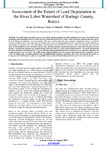Assessment of the Extent of Land Degradation in the River Loboi Watershed of Baringo County, Kenya

View/
Date
2015Author
Bitengo, Gwako Alice
Makindi, Stanley Maingi
Moturi, Wilkister N.
Metadata
Show full item recordAbstract
Increased human population pressure and climate change constitute the global underlying root causes of accelerated and
devastating land degradation processes in the Arid and Semi-Arid Lands (ASALs). River Loboi watershed, located at the lower part of
the Lake Baringo Catchment, is not an exception. The area is characterized by severe vegetation degradation that has resulted in
extreme soil deterioration. This study aimed to determine the extent of land degradation in the watershed with specific objectives of
determining the vegetation cover and composition, observing signs of accelerated soil erosion as well as assessing the socio-economic
status of the inhabitants in the watershed. Tools for data collection included structured questionnaire, observation schedules and oral
histories. The measured variables were analysed using a one-way ANOVA (α =0.05) and correlation analysis. The results indicated that
the whole watershed is degraded with 87.5% of the watershed being highly degraded and the remaining 12.5% moderately degraded. The
overall vegetation cover was 59.6%. The middle section (Simotwe location) was the worst hit and recorded the least vegetation cover of
51.4%. In addition the watershed indicated signs of transformation towards a shrubland. The results demonstrate the urgency of
developing and establishing more effective and scientific ways to curb and monitor land degradation processes in the watershed
